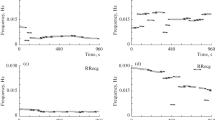Abstract
In 10 young male subjects with healthy lungs, the CO2 response curves before and after administration of diazepam (10 or 20 mg. i. m.) were determined graphically and by calculation. It was found that on account of the large error involved the graphical method should not in fact be used. After administration of diazepam, the stimulability quotient falls markedly; analysis of the breath volume and the frequency-increase lines shows that the reduction of the respiratory minute volume is caused by a significant decrease of frequency together with irregular variations of the breath volume-increase line. The increase of the pCO2 value by only 1 mm Hg after diazepam is thought to be caused by mental factors (sedation and accustoming).
Similar content being viewed by others
References
Alexander, J. K., Spalter, H. F., West, J. R.: Modification of respiratory response to carbon dioxide by salicylate. J. clin. Invest.34 533–537 (1955)
Becker, H. M., Nasser, H., Schwab, M.: Vergleichende Untersuchungen über den Einfluß von Theophyllin-Äthyldiamin (Euphyllin), Oxyäthyl-Theophyllin (Cordalin), Coramin, N-Allylnormorphin und Levallorphan auf die durch Morphin und Dromoran gehemmte Atmung. Klin. Wschr.34 891–895 (1956)
Bellville, J. W., Seed, J. C.: The effects of drugs on the respiratory response to carbon dioxide. Anesthesiology21 727–741 (1960)
Cegla, U.: Problematik und Anwendung von CO2-Antwortkurven zur Erfassung der CO2 sensiblen Atmungsregulation. Inauguraldissertation, Heidelberg 1967
Cohnstein, U., Zuntz, N.: Pflügers Arch.42 366 (1888) Quoted in Ref. [14]
Döring, G. K., Loeschke, H. H., Ochwardt, B.: Weitere Untersuchungen über die Wirkung der Sexualhormone auf die Atmung. Pflügers. Arch. ges. Physiol.252 216–230 (1950)
Eckenhoff, J. E., Oech, S. R.: The effects of narcotics and antagonists upon respiration and circulation in man. Clin. Pharmacol. Ther.1 483–524 (1960)
Geisler, L., Herberg, D.: Untersuchungen über den Einfluß einiger häufig verwendeter Pharmaka auf die Erregbarkeit des Atemzentrums beim Menschen. Therapiewoche47 1941 (1967)
Geisler, L., Herberg, D., Cegla, U., Utz, G.: Untersuchungen über die CO2-sensible zentrale Atmungsregulation an Lungengesunden und bei verschiedenen Krankheitsbildern. Schweiz. med. Wschr.5 144–150 (1968)
Geisler, L., Rost, H.-D.: Untersuchungen am Menschen über den Einfluß des neuen Psychopharmakons 1-[(Methylamino)-methyl]-dibenzo-[b,c]-bicyclo[2,2,2]octadien auf die CO2-sensible zentrale Atemregulation. Arzneimittel-Forsch.20 957–958 (1970)
Heerhaber, J., Loeschke, H. H., Westphal, U.: Eine Wirkung des Progesterons auf die Atmung. Pflügers Arch. ges. Physiol.250 42–55 (1948)
Herberg, D., Geisler, L., Schenck, P.: Über den Einfluß einiger häufig verwendeter Sedativa und Analgetica auf das Atemzentrum des Menschen, unter besonderer Berücksichtigung von Patienten mit alveolärer Hypoventilation. Med. Welt44 2219–2223 (1963)
Herberg, D., Geisler, L., Bohr, W., Utz, G.: Untersuchungen am Menschen über den Einfluß verschiedener Pharmaka auf die CO2-sensible zentrale Atmungsregulation mittels CO2-Antwortkurven. Pharmacol. Clin.1 54–62 (1968)
Julich, H.: Die Veränderung der Erregbarkeit des Atemzentrums durch erregbarkeitssenkende Arzneimittel, mit einem Beitrag zur Methodik der Erregbarkeitsbestimmung. Z. ges. exp. Med.117 539 (1951)
Lerche, D., Katsaros, B., Lerche, G., Loeschke, H. H.: Vergleich der Wirkung verschiedener Acidosen (NH4Cl, CaCl2, Aatazolamid) auf die Lungenbelüftung beim Menschen. Pflügers Arch. ges. Physiol.270 450–460 (1960)
Lindhard, J.: Scand. Arch. Physiol. (Berlin, Lpz.)26 221 (1912), quoted in Ref. [14]
Loeschke, H. H., Sweel, A., Kongh, R. H., Lambertsen, C. J.: The effect of morphin and of meperidine (Dolantin, Demerol) upon respiratory response of normal men to low concentrations of inspired carbon dioxide. J. Pharmacol. exp. Ther.108 376–383 (1953)
Loewy, H.: Pflügers Arch.47 601 (1890) — Münch. med. Wschr. 2408 (1910) quoted in Ref. [14]
Maspoli, M.: Le Valium, son action sur la respiration. Schweiz. med. Wschr.97 320 (1967)
Otis, A. B., Fenn, W. O., Rahn, H.: Mechanics of breathing in man. J. appl. Physiol.2 592 (1950)
Pauli, H. G.: Helvetica Medica Acta, Suppl. XLIV/ad Bd. 31 (1964 Fasc. 1.) Die respiratorische Säure-Base-Regulation in Physiologie und Klinik.
Schaefer, K. E.: Respiratory Pattern and Respiratory Response to CO2. J. appl. Physiol.13 1 (1958)
Schwab, M., Schmehling, E., Wagner, P. H.: Die Beeinflussung der Atmung durch Theophyllinpräparate und ihre Lösungsvermittler. Klin. Wschr.38 851–856 (1960)
Thews, G.: A microanalysis method for determination of oxygen pressure in small blood samples. Pflügers Arch. J. ges. Physiologie276 89 (1962)
Ulmer, W. T., Thews, G., Reichel, G.: Verhandl. dtsch. Ges. inn. Med. (1963)
Wendel, A., Lambertsen, C. J.: Mechanism of action of N-allylnormorphine in morphine-induced respiratory depression in man. Fed. Proc.13 497–498 (1956)
Doc. Geigy, wiss. Tabellen, 7th ed. Geigy, Basel 1969
Author information
Authors and Affiliations
Rights and permissions
About this article
Cite this article
Cegla, U.H. The use of CO2 response curves to determine the respiration-depressant action of drugs with diazepam as an example. Pneumonologie 149, 219–228 (1973). https://doi.org/10.1007/BF02096021
Received:
Issue Date:
DOI: https://doi.org/10.1007/BF02096021



